German Shorthaired Pointer
The German Shorthaired Pointer is a breed of medium-sized pointing dog developed in nineteenth century Germany.[1] It is energetic and powerful, with strong legs and great endurance. It is a versatile all-purpose gun dog suitable for hunting and retrieving on both land and water, with a strong drive to find and chase game.[2] It may also be kept as a companion dog, though as a high-energy sporting dog, it requires significant amounts of exercise.
| German Shorthaired Pointer | |||||||||||||
|---|---|---|---|---|---|---|---|---|---|---|---|---|---|
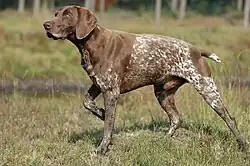 A German Shorthaired Pointer on point | |||||||||||||
| Other names |
| ||||||||||||
| Origin | Germany | ||||||||||||
| |||||||||||||
| Dog (domestic dog) | |||||||||||||
German Shorthaired Pointers have a short coat that comes in various combinations, generally a mix of liver and white. They have moderately long floppy ears set high on the head. Longer, broad, and strong, muzzles allow retrieval of heavier game. The dog's profile should be straight or strongly Roman nosed; any dished appearance to the profile is incorrect according to breed standards.[2] Their eyes are generally brown, with darker ones being desirable; yellow or "bird of prey" eyes are a fault. The tail is commonly docked, although that is now prohibited in some countries.[3] In competition, they are penalized if the tail is curved either up or down while the dog is moving.[4] When the GSP is in classic point stance, the tail should be held straight out from the body, forming a line with the pointing head and body. Like all German pointers, GSPs have webbed feet, and are known for going after waterfowl in the water.
The German Shorthaired Pointer is a member of the Sporting Group.[5] In 2016, CJ, a three-year-old German Shorthaired Pointer, won the Best in Show award at the 140th Westminster Kennel Club Dog Show.[6]
Appearance
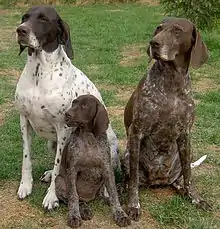
The German Shorthaired Pointer's coat is short and flat with a dense undercoat protected by stiff guard hairs, making the coat water resistant and allowing the dog to stay warm in cold weather. That allows the dog to be an agile hunter, with high performance in both field and water. The coat can be a dark brown with some lighter brown colors, referred to as "liver" (incorrectly as "chocolate" or "chestnut"), black (although any area of black is cause for disqualification in American Kennel Club-sanctioned shows), white, liver roan, or liver and white.[2][5]
Health
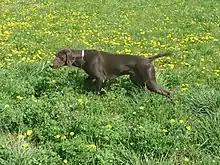
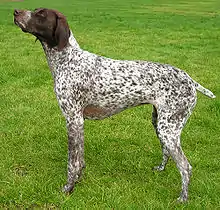
Most German Shorthaired Pointers are tough, healthy dogs, but the breed can be subject to a number of hereditary disorders due to their breeding. Some of these health disorders include, hypothyroidism, hip dysplasia, osteochondrosis dissecans (OCD), pannus, progressive retinal atrophy (PRA), epilepsy, skin disorders and cancerous lesions in the mouth, on the skin and other areas of the body.[7] As with other breeds, un-spayed female GSPs are prone to breast cancer. This risk is reduced if they are spayed.
A genetic form of lupus, termed exfoliative cutaneous lupus erythematosus (ECLE[8]) has also been recognized in German shorthaired pointer dogs.
Care
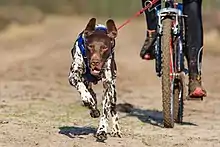
The GSP has a median lifespan of 9 years in a Danish survey and 12 years in a UK survey. In the UK survey about 1 in 8 lived to >15 years with the longest lived dog living to 17 years.[9]
History

German Hunters spent generations cross different breeds until the GSP came during the 1800s. They were very successful to the point that they are among the top-winning breeds in competitive hunting events.[10] According to the American Kennel Club,[5] it is likely that the GSP is descended from a breed known as the German Bird Dog, which itself is related to the Old Spanish Pointer introduced to Germany in the 17th century.[11] It is also likely that various German hound and tracking dogs, as well as the English Pointer and the Arkwright Pointer also contributed to the development of the breed. However, as the first studbook was not created until 1870, it is impossible to identify all of the dogs that went into creating this breed. The breed was officially recognized by the American Kennel Club in 1930.[5] World War II affected the breeding of GSP. Toward the end of the war many of the breeders hid their gold, diamonds, their GSPs and more. Then the best dogs were sent to Yugoslavia for safe keeping. Today the GSP ranks 19th among the 155 breeds and it varieties recognized by the AKC.
Current uses
Like the other German pointers (the German Wirehaired Pointer and the less well-known German Longhaired Pointer), the GSP can perform virtually all gun dog roles. It is pointer and retriever, an upland bird dog and water dog. The GSP can be used for hunting larger and more dangerous game. It is an excellent swimmer but also works well in rough terrain. It is tenacious, tireless, hardy, and reliable. German Shorthaired Pointers are proficient with many different types of game and sport, including trailing, retrieving, and pointing pheasant, quail, grouse, waterfowl, raccoons, possum, and even deer.[5]
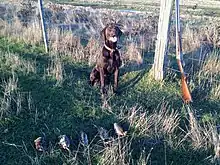
German Shorthaired Pointers are still currently used as versatile hunting and gun dogs. With their high intelligence and athleticism the German Shorthaired Pointer performs well in many AKC sports such as Agility, Dock Diving, and Obedience.[12] German Shorthaired Pointers are also used in law enforcement for nosework such as the detection of illicit substances.[13]
References
- Maxwell, C. Bede 1987. "The New German Shorthaired Pointer" Howell Book House Inc. ISBN 0-87605-157-3; p.13
- "GSP breed standard". American Kennel Club. Archived from the original on 17 May 2014. Retrieved 15 May 2014.
- "Docking worldwide". Council of Docked Breeds. Archived from the original on 2022-08-18. Retrieved 2023-03-31.
- Titus, Patte (30 September 1992). "Breed Education". www.gspca.org. Archived from the original on 11 January 2019. Retrieved 4 August 2018.
- "Get to Know the German Shorthaired Pointer". American Kennel Club. Archived from the original on 2 May 2014. Retrieved 30 April 2014.
- "2016 Winners", westminsterkennelclub.org, Westminster Kennel Club, archived from the original on 2020-02-26, retrieved 2020-02-26
- "German Shorthaired Pointer Dogs| German Shorthaired Pointer Dog Breed Info & Pictures | petMD". www.petmd.com. Archived from the original on 2016-11-30. Retrieved 2016-11-30.
- Wang, Ping; Zangerl, Barbara; Werner, Petra; Mauldin, Elizabeth A.; Casal, Margret L. (April 2011). "Familial cutaneous lupus erythematosus (CLE) in the German shorthaired pointer maps to CFA18, a canine orthologue to human CLE". Immunogenetics. 63 (4): 197–207. doi:10.1007/s00251-010-0499-z. ISSN 0093-7711. PMC 3230530. PMID 21132284.
- "Breed Longevity Data". Archived from the original on 2016-06-12. Retrieved 2012-06-26.
- "German Shorthaired Pointer Dog Breed Information". Archived from the original on 2020-02-10. Retrieved 2019-11-18.
- "Jagdhund - einzelnen Rassen und Schläge". Jäger werden (in German). 23 July 2012. Archived from the original on 22 September 2018. Retrieved 22 September 2018.
- Club, American Kennel. "German Shorthaired Pointer History & Training/Temperament". www.akc.org. Archived from the original on 2016-12-02. Retrieved 2016-12-02.
- Sole, Sarah (4 February 2019). "New K-9 Amigo has nose for law enforcement". ThisWeekNews.com. GateHouse Media, LLC. Archived from the original on 29 March 2019. Retrieved 29 March 2019.
Further reading
- Alderton, David (1984). The Dog. Quill Publishing; Chartwell Books. ISBN 0-89009-786-0.
- Barnes, Duncan (ed.) (1983). The AKC's World of the Pure-Bred Dog. Nick Lyons Books. ISBN 0-87605-406-8.
- Brown, Joan (1996). Simon the Pointer. Viking US. ISBN 0-670-86662-8.
- Cunliffe, Juliette (2004). The Encyclopedia of Dog Breeds. Parragon Publishing. ISBN 0-7525-8276-3.
- Ellis, Mel (1985). Run, Rainey, Run. Top Dogs: Northword Publishing. ISBN 0-942802-11-X.
- Fogle, Bruce, DVM (2000). The new Encyclopedia of the Dog. Doring Kindersley (DK). ISBN 0-7894-6130-7.
- Koshyk, Craig (2011). Pointing Dogs: The Continentals (Hardcover). Vol. One (1st ed.). Dog Willing Publications. p. 364. ISBN 978-0-9813523-1-2. Archived from the original on January 19, 2013. Retrieved October 29, 2015.
- Marder, Amy, VMD (2004). The Complete Dog Owner's Manual. Fog City Press. ISBN 1-74089-313-1.
- Maxwell, C Bede (1982) "The New German Shorthaired Pointer" Howell Book House. ISBN 0-87605-157-3.
- Palmer, Joan (1994). The Illustrated Encyclopedia of Dog Breeds. Wellfleet Press. ISBN 0-7858-0030-1.
- Rollston, Dr. Christopher A. "A Brief History of the German Shorthair (Deutsch Kurzhaar)." _Shorthair Journal_ Volume 7 Issue 6 (2006):8-10.
- Schuler, Elizabeth Meriwether (ed.) (1980). Simon & Schuster's Guide to Dogs. Fireside: Simon and Schuster. ISBN 0-671-25527-4.